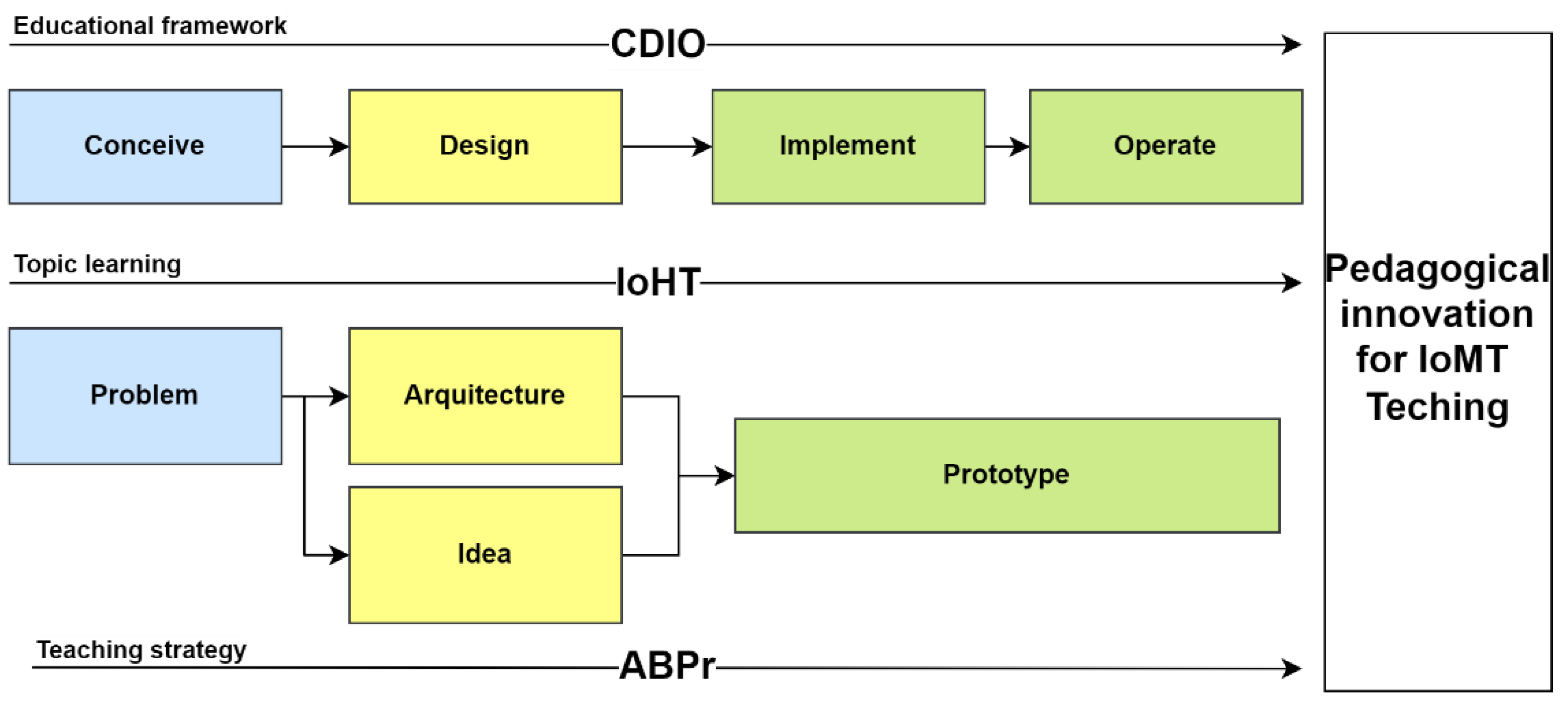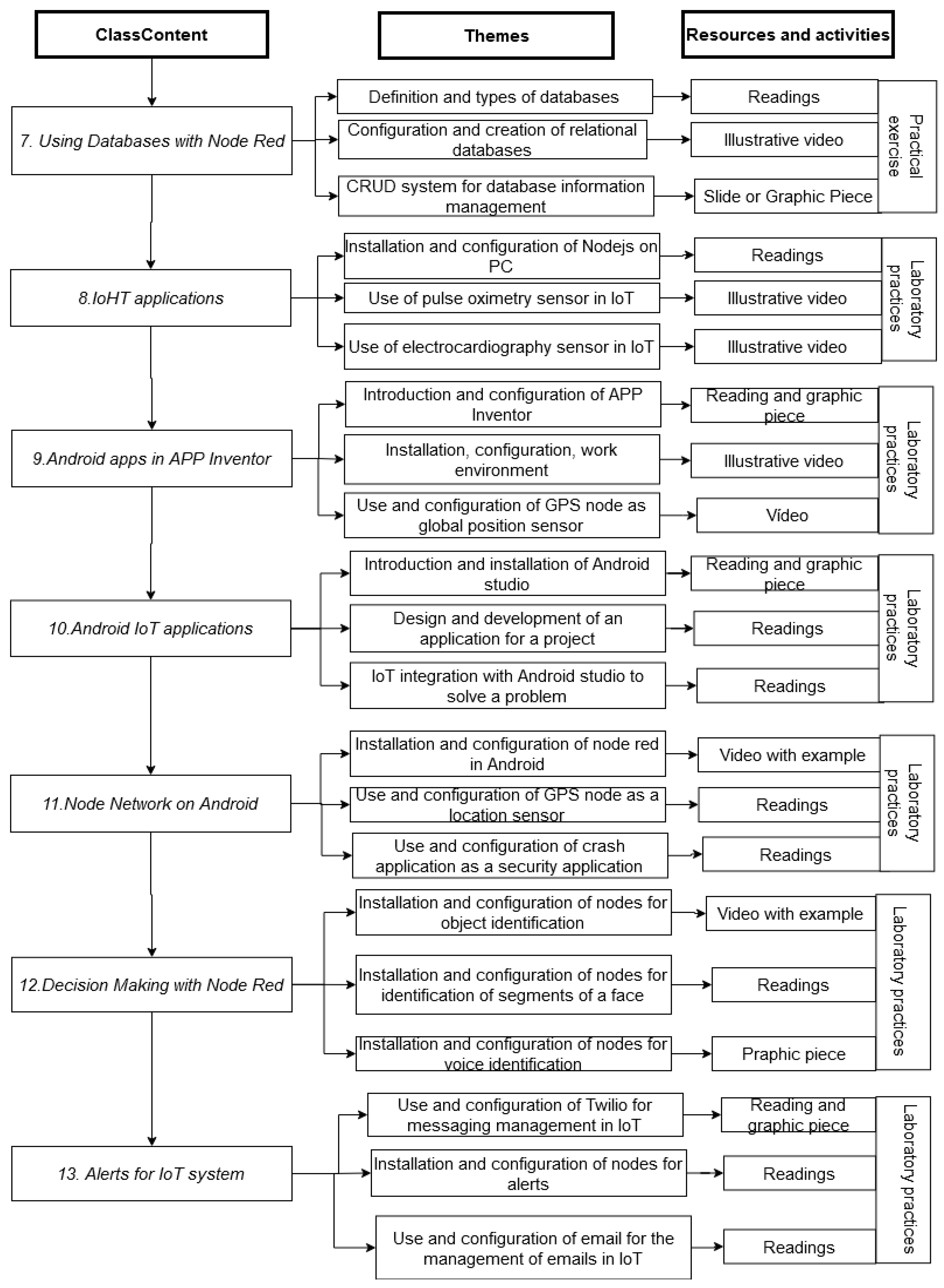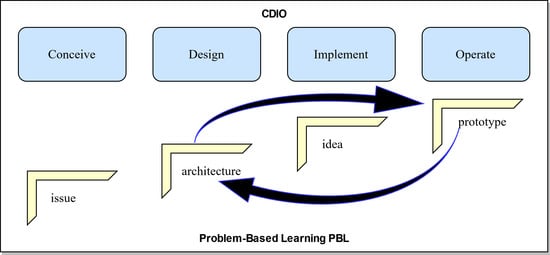Proposal of Design and Innovation in the Creation of the Internet of Medical Things Based on the CDIO Model through the Methodology of Problem-Based Learning
Abstract
:1. Introduction
2. Related Works
- Learning happens anytime, anywhere
- Learning is becoming more personalized
- The student determines how wants to learn
- Learning is increasingly project or PBL
- Learning is more practical through experiences or real cases
- There is exposure to the analysis and interpretation of data
- New forms of evaluation emerge
- Students participate in the design and updating of study plans
- Students are becoming more independent and teachers more facilitators
3. Materials and Methods
3.1. Implementation of the CDIO Syllabus and the Subject Planning
3.2. Description of the Subject Content
3.3. Materials Used for the Development of Each of the Modules
- Item 1: Arduino UNO board (connection cable)
- Item 2: Wemos D1 R1 mini card (connection cable)
- Item 3: Raspberry pi 3 microprocessor (cables and adapter)
- Item 4: Temperature and humidity sensors (DHT 11/22)
- Item 5: EMG, ECG, and heart rate sensors (Click Board/MIKROE)
- Item 6: Bluetooth module (HC-05)
- Item 7: Protoboard, some jumpers and some Light-Emitting Diodes (LEDs)
- Solution description:
- Requirements:
- Entities:
- Services:
- Events:
- Architecture:
- Connection protocols:
- Architecture:
- Layers description:
- Storage solution
4. Results
Planning Learning Outcomes
5. Discussion
6. Conclusions
Author Contributions
Funding
Institutional Review Board Statement
Informed Consent Statement
Data Availability Statement
Conflicts of Interest
References
- Mashal, I.; Alsaryrah, O.; Chung, T.-Y.; Yang, C.-Z.; Kuo, W.-H.; Agrawal, D.P. Choices for interaction with things on Internet and underlying issues. Ad. Hoc. Netw. 2015, 28, 68–90. [Google Scholar] [CrossRef]
- Lele, A. Internet of Things (IoT). In Smart Innovation, Systems and Technologies; Springer: Berlin/Heidelberg, Germany, 2019. [Google Scholar] [CrossRef]
- Ahmadi, H.; Arji, G.; Shahmoradi, L.; Safdari, R.; Nilashi, M.; Alizadeh, M. The application of internet of things in healthcare: A systematic literature review and classification. Univers. Access Inf. Soc. 2018, 18, 837–869. [Google Scholar] [CrossRef]
- McKinsey. The Future of Connectivity: Enabling the Internet of Things. Makinsey & Company. 2017. Available online: https://www.mckinsey.com/featured-insights/internet-of-things/our-insights/the-future-of-connectivity-enabling-the-internet-of-things (accessed on 25 September 2022).
- Fuchs, W. The new global responsibilities of engineers create challenges for engineering education. J. Educ. Sustain. Dev. 2012, 6, 111–113. [Google Scholar] [CrossRef]
- Fondo de Innovación Pedagógica—Universidad del Rosario. Available online: https://www.urosario.edu.co/Profesores/Becas-premios-y-distinciones/Fondo-de-Innovacion-Pedagogica/ (accessed on 25 September 2022).
- Penttila, T.; Kairisto-Mertanen, L.; Putkonen, A.; Lehto, A. Innovation pedagogy—A strategic learning approach for the future. Pedagog. Views Innov. Competences Entrep. 2013, 171, 11–23. [Google Scholar]
- Top Trends in the Gartner Hype Cycle for Emerging Technologies. 2017. Gartner. Available online: https://www.gartner.com/smarterwithgartner/top-trends-in-the-gartner-hype-cycle-for-emerging-technologies-2017 (accessed on 25 September 2022).
- Okano, M.T. IOT and industry 4.0: The industrial new revolution. In Proceedings of the International Conference on Management and Information Systems, Bangkok, Thailand, 25–26 September 2017; p. 26. [Google Scholar]
- Kranz, M. Building the Internet of Things: Implement New Business Models, Disrupt Competitors, Transform Your Industry; John Wiley & Sons: New York, NY, USA, 2016; 274p. [Google Scholar]
- Whittemore, S. White Paper: Transversal Competencies Essential for Future Proofing the Workforce; SkillaLibrary: Civitanova, Italy, 2018; 48p. [Google Scholar]
- Diwan, P. Is Education 4.0 an imperative for success of 4th Industrial Revolution? 2017. Available online: https://medium.com/@pdiwan/is-education-4-0-an-imperative-for-success-of-4th-industrial-revolution-50c31451e8a4 (accessed on 25 September 2022).
- Postholm, M.B.; Rokkones, K. Teachers’ and School Leaders’ Perceptions of Further Education and Learning in School. Creat. Educ. 2015, 6, 2447–2458. [Google Scholar] [CrossRef] [Green Version]
- Amaxilatis, D.; Akrivopoulos, O.; Mylonas, G.; Chatzigiannakis, I. An IoT-Based Solution for Monitoring a Fleet of Educational Buildings Focusing on Energy Efficiency. Sensors 2017, 17, 2296. [Google Scholar] [CrossRef] [PubMed] [Green Version]
- Ruiz-Rube, I.; Mota, J.M.; Person, T.; Corral, J.M.R.; Dodero, J.M. Block-based development of mobile learning experiences for the internet of things. Sensors 2019, 19, 5467. [Google Scholar] [CrossRef] [PubMed] [Green Version]
- Radcliffe, P.J.; Kumar, D. Is problem-based learning suitable for engineering? Australas. J. Eng. Educ. 2016, 21, 81–88. [Google Scholar] [CrossRef]
- de Araújo, R.G.B.; da Costa, M.V.A.; Joseph, B.; Sánchez, J.L.G. Developing professional and entrepreneurship skills of engineering students through problem-based learning: A case study in Brazil. Int. J. Eng. Educ. 2020, 36, 155–169. [Google Scholar]
- Burd, B.; Barker, L.; Pérez, F.A.F.; Russell, I.; Siever, B.; Tudor, L.; Pollock, I. The internet of things in undergraduate computer and information science education: Exploring curricula and pedagogy. In Proceedings of the Companion of the 23rd Annual ACM Conference on Innovation and Technology in Computer Science Education, New York, NY, USA, 2–4 July 2018; pp. 200–216. [Google Scholar]
- Edström, K.; Kolmos, A. PBL and CDIO: Complementary models for engineering education development. Eur. J. Eng. Educ. 2014, 39, 539–555. [Google Scholar] [CrossRef]
- Tamaki, K.; Arakawa, M.; Arame, M.; One, Y. Development of educational programs for system creators and business producers in future strategy design based on action project group activities through industry-university cooperation. J. Mech. Eng. Autom. 2019, 9, 243–247. [Google Scholar]
- Svane, T.E.; Zhu, M.; Johansson, L.O.; Ebbesson, E. Like a snowball: Adding layers of knowledge Enchanting student work with student input. In Proceedings of the 2017 16th International Conference on Information Technology Based Higher Education and Training (ITHET), Ohrid, Macedonia, 10–12 July 2017; IEEE: Piscataway, NJ, USA; pp. 1–6. [Google Scholar]
- CDIO Initiative. El Programa de Estudios CDIO. Obtenido de. The Context of Engineering Education. In Proceedings of the 4th International CDIO Conference, Ghent, Belgium, 17–19 June 2008; Crawley, E.F., Cha, J., Malmqvist, J., Brodeur, D.R., Eds.; Available online: http://www.cdio.org/ (accessed on 25 September 2022).
- Bisagni, C.H.; Chiringhelli, G.; Ricci, S. Survey for program evaluation of aerospace engineering at politecnico di milano. In Proceedings of the 6th international CDIO Conference, École Polytechnique, Montréal, Canada, 15–18 June 2010; pp. 1–13. [Google Scholar]
- Almada-Lobo, F. The industry 4.0 revolution and the future of manufacturing execution (MES). J. Innov. Manag. 2016, 3, 16–21. [Google Scholar] [CrossRef]
- Taiji, H. Practical Node-RED Programming: Learn Powerful Visual Programming Techniques and Best Practices for the Web and IoT.; Packt Publishing Ltd.: Birmingham, UK, 2021; ISBN 978-1800201590. [Google Scholar]
- Node-RED: Flow-Based Programming for the Internet of Things. Available online: https://nodered.org (accessed on 25 September 2022).
- Japón, B.R. Learn IoT Programming Using Node-RED: Begin to Code Full Stack IoT Apps and Edge Devices with Raspberry Pi, NodeJS, and Grafana; Bpb Publications: Noida, India, 2022; p. 242. ISBN 978-93-91392-383. [Google Scholar]
- Brennon, R.; Edström, K.; Hugo, R.J.; Roslöf, J.; Songer, R.; Spooner, D. The 13th International CDIO Conference Proceedings—Full Papers. Schulich School of Engineering. 2017. Available online: https://prism.ucalgary.ca/handle/1880/52101 (accessed on 25 September 2022).
- Makeblock. Makeblock Education. Available online: https://www.makeblock.com/ (accessed on 25 September 2022).
- Lavrentieva, O.O.; Rybalko, L.M.; Tsys, O.O.; Uchitel, A.D. Theoretical and methodical aspects of the organization of students’ independent study activities together with the use of ICT and tools. Educ. Dimens. 2019, 53, 27–59. [Google Scholar] [CrossRef]
- Sakhapov, R.; Absalyamova, S. Fourth industrial revolution and the paradigm change in engineering education. MATEC Web Conf. 2018, 245, 12003. [Google Scholar] [CrossRef]










| Goals | Methodology | Pros |
|---|---|---|
| Transdisciplinary, intercultural competencies and social intelligence skills [11] | Use of gaming platforms for group collaboration | Prospective methodologies from the Delphi technique |
| Traditional education with readings and learning environments [12] | Use of web resources and inter-institutional groups | Active collaboration and learning methodologies with virtual interaction |
| Personalized and repetitive frameworks for education [13] | Permanent learning and peer learning with teachers more as facilitators | Interaction between human and machine, using technology and its benefits |
| Raise awareness among young people regarding behaviors and habits in the use of energy and natural resources [14] | Teacher’s guide under a real environment in terms of scalability, responsiveness, and simplicity through elements based on the web, mobile, forums, and others | Use of open-source technologies and services with app-based solutions used for educational purposes |
| Previous knowledge/experience with technology applications [15] | Practical workshop and experimental research in a mobile application development course | Use of App Inventor and interdisciplinary work |
| Credits | Lesson Planning | Expected Learning Outcomes (RAEs) |
|---|---|---|
| 3 | Class 20% Lab practice 80% | Implement mathematical models through axioms, theorems, and laws, as well as analyze the results from the field of mathematics. Solve problems, design processes, and carry out experiments typical of biomedical engineering using computer tools for the capture, processing, simulation, and visualization of information. Develop algorithms that are coded, debugged, and executed in graphical programming environments using structured programming methodologies and stream-based programming that solve specific tasks typical of the application of IoHT systems. |
Publisher’s Note: MDPI stays neutral with regard to jurisdictional claims in published maps and institutional affiliations. |
© 2022 by the authors. Licensee MDPI, Basel, Switzerland. This article is an open access article distributed under the terms and conditions of the Creative Commons Attribution (CC BY) license (https://creativecommons.org/licenses/by/4.0/).
Share and Cite
Sarmiento-Rojas, J.; Aya-Parra, P.A.; Perdomo, O.J. Proposal of Design and Innovation in the Creation of the Internet of Medical Things Based on the CDIO Model through the Methodology of Problem-Based Learning. Sensors 2022, 22, 8979. https://doi.org/10.3390/s22228979
Sarmiento-Rojas J, Aya-Parra PA, Perdomo OJ. Proposal of Design and Innovation in the Creation of the Internet of Medical Things Based on the CDIO Model through the Methodology of Problem-Based Learning. Sensors. 2022; 22(22):8979. https://doi.org/10.3390/s22228979
Chicago/Turabian StyleSarmiento-Rojas, Jefferson, Pedro Antonio Aya-Parra, and Oscar J. Perdomo. 2022. "Proposal of Design and Innovation in the Creation of the Internet of Medical Things Based on the CDIO Model through the Methodology of Problem-Based Learning" Sensors 22, no. 22: 8979. https://doi.org/10.3390/s22228979






